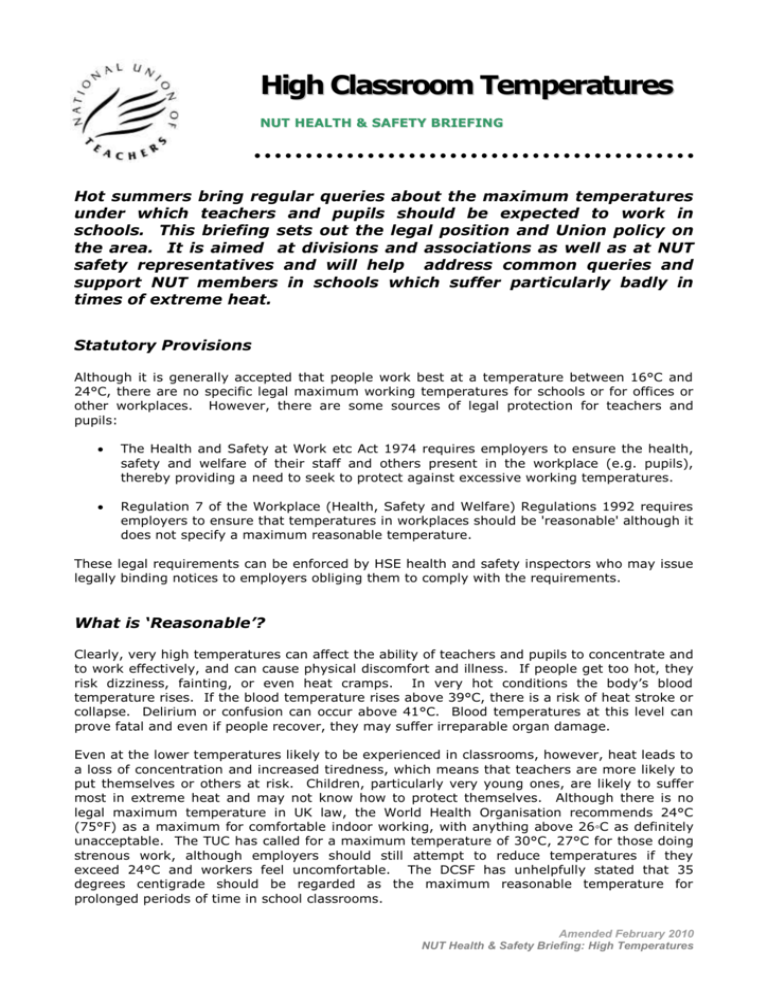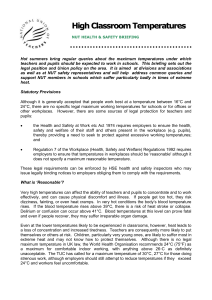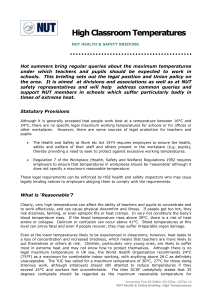HIGH-CLASSROOM-TEMPERATURES
advertisement

High Classroom Temperatures NUT HEALTH & SAFETY BRIEFING Hot summers bring regular queries about the maximum temperatures under which teachers and pupils should be expected to work in schools. This briefing sets out the legal position and Union policy on the area. It is aimed at divisions and associations as well as at NUT safety representatives and will help address common queries and support NUT members in schools which suffer particularly badly in times of extreme heat. Statutory Provisions Although it is generally accepted that people work best at a temperature between 16°C and 24°C, there are no specific legal maximum working temperatures for schools or for offices or other workplaces. However, there are some sources of legal protection for teachers and pupils: The Health and Safety at Work etc Act 1974 requires employers to ensure the health, safety and welfare of their staff and others present in the workplace (e.g. pupils), thereby providing a need to seek to protect against excessive working temperatures. Regulation 7 of the Workplace (Health, Safety and Welfare) Regulations 1992 requires employers to ensure that temperatures in workplaces should be 'reasonable' although it does not specify a maximum reasonable temperature. These legal requirements can be enforced by HSE health and safety inspectors who may issue legally binding notices to employers obliging them to comply with the requirements. What is ‘Reasonable’? Clearly, very high temperatures can affect the ability of teachers and pupils to concentrate and to work effectively, and can cause physical discomfort and illness. If people get too hot, they risk dizziness, fainting, or even heat cramps. In very hot conditions the body’s blood temperature rises. If the blood temperature rises above 39°C, there is a risk of heat stroke or collapse. Delirium or confusion can occur above 41°C. Blood temperatures at this level can prove fatal and even if people recover, they may suffer irreparable organ damage. Even at the lower temperatures likely to be experienced in classrooms, however, heat leads to a loss of concentration and increased tiredness, which means that teachers are more likely to put themselves or others at risk. Children, particularly very young ones, are likely to suffer most in extreme heat and may not know how to protect themselves. Although there is no legal maximum temperature in UK law, the World Health Organisation recommends 24°C (75°F) as a maximum for comfortable indoor working, with anything above 26◦C as definitely unacceptable. The TUC has called for a maximum temperature of 30°C, 27°C for those doing strenous work, although employers should still attempt to reduce temperatures if they exceed 24°C and workers feel uncomfortable. The DCSF has unhelpfully stated that 35 degrees centigrade should be regarded as the maximum reasonable temperature for prolonged periods of time in school classrooms. Amended February 2010 NUT Health & Safety Briefing: High Temperatures Page 2 of 6 The NUT believes that because of the nature of the way in which teachers work, and the presence of children, a maximum indoor working temperature lower than the TUC recommendation is appropriate. NUT policy, therefore, as agreed at Annual Conference 2007, is that 26°C should be the absolute maximum temperature in which teachers should be expected to work, other than for very short periods. It is important that all schools have in place contingency plans to help staff and pupils cope with the heat. There is little that can be done to alleviate particular problems if schools do not plan in advance and also take note of the weather forecast for the week ahead. What Precautions must be Taken? The HSE’s Approved Code of Practice (ACoP) on the 1992 Regulations requires employers to take all reasonable steps to achieve a reasonably comfortable temperature (paragraph 46 of the ACoP). The ACoP requires workplaces to be ventilated by a sufficient quantity of fresh or purified air. Windows which are intended to be opened to allow natural ventilation should therefore be able to be opened. Where windows are not intended to be opened, there should be an alternative means of artificial ventilation. The ACoP also states that shade should, where necessary, be provided by window blinds and that special measures such as electric fans or portable air cooling equipment should be provided where necessary. The NUT expects schools to implement planned measures to reduce temperatures as soon as staff complain that working conditions are beginning to become uncomfortable or as soon as it is known that temperatures are going to become uncomfortable, according to the weather forecast. If in doubt, 26°C should be used as the trigger for these measures. Measures that could be considered include the following. Introducing a properly designed air conditioning system into the building: In some buildings this is not possible, either because of the age or type of the building, or because of planning restrictions. A properly maintained air conditioning system is a very effective way of reducing temperatures. However, air conditioning systems do use a very high level of power and other, more environmentally friendly, solutions should also be considered. Redesigning the work area: Often simply moving people away from windows, or reducing heat gain by installing reflective film or blinds to windows can be a very effective way of keeping a workplace cooler. The installation of fans or natural ventilation: Providing fans or windows that open can also help staff and pupils to cool down, although both these become less effective at higher tempertures. Portable air-cooling cabinets are also available, which are much more effective. Development of shady areas over time, either through planting of treed or the construction of shelters in playgrounds. Curtailing of certain heat-generating activities, for example, use of computers, bunsen burners, ovens, design and technology equipment, strenuous physical activity in PE lessons etc; unless effective heat extraction measures can be put in place. Provision of water coolers. Permission to be given for pupils to drink water in classrooms. (The NUT is in fact in favour of this at all times of the year). Amended Feb 2010 NUT Health & Safety Briefing: High Temperatures Page 3 of 6 Reallocation of classes to cooler rooms whenever possible. Relaxation of dress codes for staff and pupils. Appropriate changes to the school lunch menu. Ensuring that windows can be safely opened. Installation of blinds and/or reflective film on windows. Use of portable air conditioning units in the worst affected classrooms/staff room (although these can be noisy). Provision of suitably-sized fans for those rooms which are not so badly affected. Timetabling sports days for earlier in the summer term. Consideration of the needs of pregnant teachers who will feel the effects of the heat more acutely than anyone else and may, for example, need to be excused playground duty. Starting and finishing school early, provided that adequate notice has been given to parents. The requirement to take ‘all reasonable steps’ means that employers cannot use cost as an excuse, other than where the measures would be disproportionately expensive. Again, these legal requirements can be enforced by HSE health and safety inspectors who may issue notices to employers obliging them to comply with these requirements. The NUT considers that, in schools, other steps may also need to considered such as closing classrooms which are unacceptably hot and teaching classes elsewhere, or even sending pupils home, provided reasonable notice has been given to parents. It is important not to neglect security issues which will arise when windows and doors are left open and to consider the risks posed by intruders. Building Schools for the Future (BSF) Good design should always take account of the need to provide comfortable working temperatures. The BSF programme is a 15-year programme to rebuild or renew every secondary school in England. It is important that the school workforce is consulted on designs for new schools. It is stated on the www.bsf.gov.uk website that `staff will have the chance to get involved in the consultation process of the future design of your school’. It is important that such consultation does take place so that NUT divisions/associations and school staff ar able to feed in their concerns. BSF is a once in a lifetime opportunity to build schools which are comfortable to work in all year round. This should be fundamental to the design brief, but it can all too easiily be overlooked. Performance standards have been set for new school buildings in DCSF Building Bulletin 101. Unfortunately they have been set at a level which offers very little protection to the occupants of new school buildings. The performance standards for summertime overheating are as follows: (a) There should be no more than 120 hours a year when the air temperature in the classroom rises above 28 degrees centigrade Amended Feb 2010 NUT Health & Safety Briefing: High Temperatures Page 4 of 6 (b) The average internal temperature difference should not exceed 5 degrees centigrade (i.e. the internal temperature should be no more than 5 degrees above the external temperature on average). (c) The internal temperature when the space is occupied should not exceed 32 degrees centigrade. In order to show that the proposed new school will not suffer overheating, two of these three criteria must be met. Ventilation Requirements Ventilation requirements for schools are laid down in the Education (School Premises) Regulations 1999. These state that all occupied areas in a school building shall have controllable ventilation at a minimum rate of 3 litres of fresh air per second for each of the maximum number of persons the area will accommodate. Teaching accomodation shall also be capable of being ventilated at a maximum rate of 8 litres of fresh air per second for each of the usual number of people in these areas when they are occupied. The Government has consistently refused to introduce a maximum working temperature into Regulations, in line with the minimum temperature proection. They published revised design criteria for schools in Building Bulletin 101 – Ventilation in Schools in July 2006. This can be downloaded from www.teachernet.gov.uk/iaq. `Class Cool Tool’ The DCSF has published a `Class Cool Tool’ for testing compliance with BB101 for the prevention of summertime over-heating. An extract from the `Class Cool Tool’ offers some suggestions on measures to be taken during hot weather is attached as Appendix One. Taking Action on High Temperatures The Union advises that where any problems are encountered in schools as a result of high temperature, NUT safety representatives should take these up as a matter of urgency with the headteacher and seek to resolve the situation so as to protect both the health and welfare of staff and pupils and the educational progress of pupils who find it difficult to concentrate in sustained high temperatures. If any problems arise, such as the headteacher refusing to take the actions outlined in this briefing note, or if adjustments made do not have any significant effect, NUT safety representatives are advised to contact their NUT division or association or their NUT Regional Office in England, or NUT Cymru in Wales, for further advice and assistance. Amended Feb 2010 NUT Health & Safety Briefing: High Temperatures Page 5 of 6 APPENDIX ONE EXTRACT FROM THE DCSF `CLASS COOL TOOL’ `During periods of potential overheating including heatwaves, all unwanted heat gains into the building should be minimised during the day and night, to allow the building’s internal air structure to cool down whenever possible. Naturally, a pre-requisite is that the heating system for the whole building should be turned off throughout the heatwave. Note the domestic hot water system should remain in operation as normal. Building-related measures to lessen the impact of heatwaves fall into the following areas: a) Reduction of casual gains – Keep the use of electric lighting to a minimum during heatwaves. All electrical equipment, including computers, monitors and printers should be completely switched off when not in use and should not be left in `standby mode’. b) Reduction of solar gains – Awnings and other forms of external solar shading can be fitted to classrooms to stop the sun’s heat reaching the space. These can be temporary for summer use or permanently installed. Solar shading should not restrict ventilation or window openings. Providing external shading prevents both the solar glare and the solar heat gain from entering the classroom whereas internal blinds allow the heat into the classroom and often prevent the windows from being opened fully for summertime ventilation. c) Increase of daytime ventilation rate, if the external temperature is close to or less than internal temperatures – all windows, other natural ventilation devices and internal doors should be fully opened in rooms as permitted by health and safety regulations. This increases the capability of natural ventilation to remove heat and increases internal air speeds. However, fire and smoke control strategies should not be compromised by inappropriate opening of fire doors. d) Increased night-time ventilation rate to cool the internal structure of the buiding and its contents – Windows, purpose-provided ventilation openings and internal doors should be left open overnight in a secure manner. If this is not possible for security reasons, it should be considered whether they can be opened in the morning, as early as possible before teaching begins. As many as possible of these measures should be used. In addition, certain further temporary measures are available as a last resort, although these have energy, financial, carbon dioxide emission consequences, as well as their own localised thermal comfort and noise implications: e) Increased air speeds using oscillating mechanical fans – such fans are themselves heat sources, so should be used cautiously. f) Use of temporary local room air conditioners or dehumidifiers – exhaust heat from such units should be ducted directly outside the building using temporary ducts; free standing units without such ducts should not be used as their net effect is to heat the room further. Occupant-and Management-Related Measures During Heatwaves There are several occupant-and management-related measures which may be considered to mitigate the effects of heatwaves. As many as possible of these measures should be used. These include: a) All staff and students should be encouraged to wear appropriate summer clothing – Comfort in summer is improved by suitable summertime clothing. At the moment, many schools have the same uniform throughout the year. b) Drinking water should be provided throughout the day. Amended Feb 2010 NUT Health & Safety Briefing: High Temperatures Page 6 of 6 c) General activity levels (and hence metabolic rate) should be reduced whenever practical. This could include, for example, cancelling sports lessons during periods of very high external temperature. d) Exposure to direct sunlight should be minimised during periods of highest solar intensity, including during break times. e) Earlier school start and finish times could be arranged to avoid teaching during periods of very high external temperature. f) Use clasrooms or other spaces with less tendency to overheat in preference to those that do, and adjust the layout of teaching spaces to avoid direct solar exposure to occupants.’ The full text of Class Cool Tool is available on the DCSF http://www.teachernet.gov.uk/_doc/9953/Building%20Bulletin%20101%20%20Version%201.4.doc#_Toc139879378 website at Amended Feb 2010 NUT Health & Safety Briefing: High Temperatures








![afl_mat[1]](http://s2.studylib.net/store/data/005387843_1-8371eaaba182de7da429cb4369cd28fc-300x300.png)


![About Heatwaves [WORD 511KB]](http://s3.studylib.net/store/data/006651441_1-a84046430e26dbbf57769d77a947717e-300x300.png)